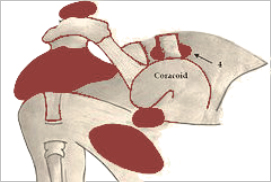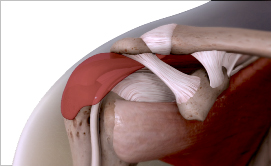What is Shoulder Bursitis?
Shoulder bursitis is an injury or inflammation of the shoulder's bursa.
About Shoulder Anatomy?
The shoulder is a complex joint that allows full movement of the arm. It offers a wide range of motion, but also makes it vulnerable to injury.
The shoulder is a 'ball-and-socket' joint. A ‘ball' at the top of the upper arm bone, humorous, fits neatly into a 'socket’, called the glenoid, which is part of the shoulder blade, scapula.
At the shoulder, three major bones meet and create a 90-degree angle. These bones are the
- collarbone (clavicle)
- the shoulder blade (scapula)
- humerus, the largest bone of the arm.
Three joints are formed from the junctions of these three bones and the sternum. These joints are the:
- glenohumeral joint,
- acromioclavicular (AC) joint and,
- sternoclavicular joint.
Each joint in the shoulder is surrounded by cartilage for padding, ligaments to connect the bones, muscles and tendons to attach the muscles to the bones.
What is a Shoulder Bursa?
The shoulder’s bursae are small fluid-filled sacs around the shoulder joint that cushions the bones, tendons and muscles of the shoulder.
Your shoulder has a number of bursae including:
- subacromial bursa
- subdeltoid bursa
- subcoracoid bursa
- coracoclavicular bursa
- supra-acromial bursa
What are the Most Common Forms of Bursitis of the Shoulder
Bursitis is a painful condition that affects the bursa and is caused when the bursa becomes inflamed. Bursitis often occurs near joints that perform frequent repetitive motion.
- Subacromial Bursa is the most commonly inflamed of the shoulder bursa. It helps with smooth movement when the arm is lifted above the head.
The Subacromial Bursa is a large bursa at the tip of the shoulder. It is located below the shoulder deltoid muscle and the rotator cuff and helps free motion by reducing friction in your shoulder.
Subacromial bursitis is usually related to shoulder impingement of your bursa between your rotator cuff tendons and bone (acromion).
- Subdeltoid Bursa is a less commonly inflamed shoulder bursa.
Shoulder Bursitis vs Shoulder Impingement
Shoulder Impingement syndrome can result from a number of conditions which can include:
- Bony spurs on the undersurface of the acromion,
- Inflammation associated with a rotator cuff tear
- Poor posture and tight anterior chest wall muscles (pectoral muscles), and
- Shoulder Bursitis
So Shoulder Bursitis is a common cause of Shoulder Impingement.
What Does Shoulder Bursitis Feel Like?
When your arm is:
- at Rest and at your side, the bursa protrudes laterally and is not normally impinged (unless it is grossly inflamed),
- elevated and further out to the side, the bursa rolls beneath the bone. This can increase the impingement,
- further elevated and above your shoulder, the bursa rolls clear the impingement zone and your pain can ease.
- extended to be adjacent to your ear, impingement may return.
Symptoms of Shoulder Bursitis?
Shoulder bursitis commonly presents with the following symptoms:
- Gradual onset of your shoulder symptoms over weeks or months,
- Pain on the outside of your shoulder,
- Pain may spread down your arm towards the elbow or wrist,
- Pain made worse when lying on your affected shoulder,
- Pain made worse when using your arms above your head,
- Painful arc of movement – shoulder pain felt between 60 - 90° of the arm moving up and outwards,
- When your arm is by your side there is minimal pain and above 90° relief of pain, and
- Shoulder pain with activities such as washing hair, reaching up to a high shelf in the cupboard.
What Causes Shoulder Bursitis?
Bursitis around the shoulder can be caused by
- repeated minor trauma
- overuse of the shoulder joint and muscles
Overuse is the cause, this can lead to Tendonitis of the Rotator Cuff Tendons or Shoulder Impingement
Diagnosis of Shoulder Bursitis
Using a manual test to differentiate Shoulder Bursitis from a Rotator Cuff Injury is fairly straightforward.
Confirmation your condition via an ultrasound scan is helpful to confirm subacromial bursitis. An MRI scan may also be useful.
Rotator Cuff Tears or Rotator Cuff Tendinopathy often coexist with Shoulder Bursitis.
How Can Shoulder Bursitis Be Treated?
For chronic or persistent shoulder bursitis there are a number of therapies available. These include:
- Corticosteroid Injections - a Corticosteroid Injection will help reduce inflammation
- Physiotherapy
- Surgery - surgical excision of the bursa where calcific bursitis (bone growth within the bursa) is involved
Shoulder Bursitis Pain Relief
In the early phases of Shoulder Bursitis, you’ll most likely be unable to fully lift your arm or sleep comfortably. Pain relief is usually a very high priority for patients who are suffering from acute shoulder bursitis.
Researchers have concluded that there are several stages that need to be covered to effectively relieve your Bursitis Pain in the short-term and then prevent your bursitis from returning in the future. These stages are:
- Injury Prevention
- Regain Full Range Of Motion
- Restore Normal Scapular and Neck Function
- Regenerating Rotator Cuff Strength
- Rebuild Power, Speed, and Agility
Shoulder Bursitis Prevention
Eliminating the causes of primary and secondary impingement is the key to preventing Shoulder Bursitis problems. So improving body and shoulder posture, stretching, shoulder stability exercises are helpful approaches.
What if Shoulder Bursitis is Left Untreated?
If Shoulder Bursitis is left untreated, the condition can worsen and result in recurrent rotator cuff or shoulder impingement problems.
Your Next Step
If you are experiencing any of the above symptoms Dr Austin Vo can offer advice on a possible diagnosis, further investigations and suitable treatment.
We would advise that you see your general practitioner to obtain a referral to see Dr Vo at Melbourne Shoulder & Knee and arrange an appointment now for peace of mind and body.
Dr Austin Vo is a specialist orthopaedic surgeon in Melbourne who is focused on conditions and treatments for the Shoulder and Knee.
